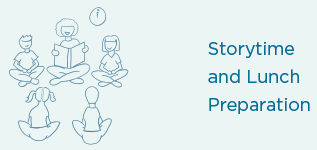CHAPTER Five
Establishing a Safe and Inviting Environment for Learning
The physical environment sets the tone for all that goes on in your program. It is the key factor in setting the stage for implementing the curriculum and, when designed with the needs of all children in mind, enables children to feel safe and valued so that they can learn and thrive. Looking at your environment through the eyes of a child who has experienced trauma can give you new insights as to how to best design and use your environment to promote healing.
In addition, because the physical environment can either affirm or suppress children’s identities, it is critical to use materials and furnishings that support all children’s cultures, races, needs, and interests. However unintentional it may be, the program environment can itself be a form of racial microaggression (Sue et al. 2007). If, for example, the books on display, the music that is available to listen to, or the food choices offered reflect the cultures of only some of the children, families, and staff, some will feel that they are not a part of the learning community.
According to the Reggio Emilia approach, there are three teachers in the life of a child: the parent, the teacher, and the environment. The environment represents a program’s values about children and should reflect the belief that children have a right to learn in beautiful spaces designed with their needs in mind (Biermeier 2015). This philosophy applies to all children, particularly those who have endured trauma. Whether or not your program follows the Reggio Emilia approach, the physical environment is a critical component.
The way you design your space can make children feel good about themselves and learning. You establish an environment that makes children feel secure, respected, and valued through
❯ Arranging the physical space for exploring and learning
❯ Providing developmentally appropriate toys, materials, and equipment, including a calming area where children can regulate their emotions and books that will help children heal and learn
❯ Establishing a program structure that brings order and predictability to the day
Design a Physical Environment That Supports Children’s Emotional, Social, Physical, and Learning Needs
As you set up a healing-centered environment, be sure that the children who work and play there are picking up messages that reflect your teaching goals. Strive to have an environment where children feel the following:
❯ I am safe.
❯ I am valued.
❯ I belong.
❯ People care about and support me.
❯ I can do things on my own.
❯ I can make and play with friends.
❯ There are interesting things to learn.
❯ I can be my authentic self and explore my identity.
❯ My background and identity are respected.
❯ I can calm myself down when I’m upset.
❯ I can make choices.
❯ I can make mistakes.
❯ This is a place that encourages hope and optimism.
❯ This is a fun place to be.
How you set up the space and encourage children to use it tells them what their time at the program will be like. For example, if there are large open spaces where children can run around and get in each other’s way, children are likely to perceive this to be a place where they might get hurt, where chaos rules, and where there is the same unpredictability that often comes with trauma. Conversely, if the space is arranged so that children can play safely, choose and return materials on their own, and move around without knocking into furniture or other people, children are more likely to feel that this is a safe place they can explore.
When you arrange the environment, try getting down to the children’s height so you can adjust furniture and materials to match the children’s perspective. “Environmental Supports for Children with a History of Trauma,” offers suggestions for designing your program’s environment. These will support all the children you teach, but special thought has been given to making the environment responsive to children with a history of trauma.
Provide Materials and Equipment that Support Learning and Healing
Selecting toys, materials, and equipment to support children who have experienced trauma starts with the same developmentally appropriate principles for all early childhood programs. Ensure that all children’s cultures and languages are represented in books, recipe cards, play foods and utensils, music and musical instruments, dramatic play clothing, and prop boxes. Understand where each child is developmentally and provide materials that allow them to experience success and also be challenged to learn new skills and concepts. Keep in mind that children with a trauma history may not be at the same developmental level as many other children their age. Also, materials and equipment must be safe for children’s use and should encourage each child to explore, experiment, take risks, be creative, and solve problems.
Not all materials need to be purchased. With help from the children’s families, you can make musical instruments, cardboard blocks, games, puppets, flannel boards, prop boxes for dramatic play, and many other materials and props. Doing so makes for fun, rewarding projects and helps keep costs down.
As you put together your inventory, focus on two special categories of materials that support children who have experienced trauma. The first group of materials is for a calming area. The second is for your book or library center.
Provide a Calming Center
While each component of the environment is important, children who have lived with trauma benefit from having an area where they can go to calm down when they are in a reactive mode. While in a fight-flight-freeze state, children cannot focus or listen to anyone trying to interact with them. They need a sensory break to de-escalate their fears and regulate the emotions that are overwhelming their brains.
When children are in this state, they typically feel like running away or hiding in a corner. Provide a safe haven for them—a nook, a corner area, a loft, or any place away from noisy areas with a lot of action, such as the block and water play areas. Some teachers like to enclose the space by putting up a tent or a beach umbrella or suspending mosquito netting from the ceiling. Give the space a name, like “cozy corner,” “calming center,” “peace place,” or “cool-down corner.” The important thing is that this space be dedicated to this one purpose and that children are aware of and encouraged to go there whenever they need to decompress.
Environmental Supports for Children with a History of Trauma
Environmental Feature |
How this Supports Children Who Have Experienced Trauma |
The inside and outside areas are free of health and physical dangers, allowing children to explore and experiment. |
Children gain a sense of safety and security when they can play with enthusiasm without fear of being harmed. |
There is a welcoming area where families drop off and pick up children, communicate with educators, and find parenting and program resources. |
Children are comforted and have less separation anxiety when their family members help transition them to and from the program. |
Walls and furnishings are painted in neutral colors, and natural materials are used throughout. |
Neutral colors and spaces promote calming and healing. Brain research shows that it is difficult for children to visually process a multitude of colors and stay on task (Dionne-Dostie et al. 2015). Bright colors may trigger the fight-flight-freeze response in children with a history of trauma. |
When possible, natural lighting is used rather than fluorescent lights. When needed, soft floor lighting in corners of the room is turned on. Filters are used to minimize the harshness of fluorescent lights. |
Bright lights are triggering for many children. Too much lighting can cause overstimulation and distractions (Vasandani 2015). |
Bathrooms have child-size toilets and sinks, and handwashing materials are accessible. |
Children take care of their own needs on their own schedules when bathrooms are designed for independent use. The experience of using the bathroom as a group can be triggering to some children and works against self-regulation. |
Areas of the room are devoted to sensory exploration, such as sand and water tables, playdough and clays, and finger painting. |
Children under stress need to self-regulate so they can pay attention and learn. Sensory play helps children become calm, work through emotions, and gain a sense of control over their environment. |
Photographs of children and families are prominently displayed in cubbies, on room dividers, in the daily schedule, and in albums of field trips and home visits. There is an “All About Me” book for each child in the library center. |
Photos reinforce a sense of belonging and comfort, especially for children who are feeling the pangs of separation. Seeing photos of themselves makes children feel appreciated as individuals and as members of a diverse learning community. |
The room is neat and uncluttered. Displays are organized and appealing to the eye. |
Overcrowded walls are distracting and negatively affect children’s abilities to focus and learn (Association for Psychological Science 2014). Organized displays support a calming, less triggering environment and avoid overstimulating children’s sensory systems. |
In center-based programs, nap or rest time takes place in the classroom, with cots or mats placed where the children prefer. In both center-based and family child care programs, night lights are available. Adults stay close by. |
Choices about where to nap and whether to have a light give children control of the situation, provide security, and reduce the chances of bad memories being triggered. |
Self-serve snacks are available when children arrive and after nap or rest time. Children follow written and picture directions and sign their names on a sheet so teachers know who has eaten. |
Making snacks self-serve puts children in control of their needs by letting them decide when they want to eat. Self-serving avoids stigmatizing children who come to the program not having eaten and supports independence and learning. Time is used more efficiently, allowing children more time to play in centers. |
Set up the area to be welcoming. Use soft lighting. Stock the area with manipulatives and materials you feel will enable children to get out strong feelings and unwind, like these:
❯ Beanbag chairs, pillows, or floor cushions
❯ Rocking chair
❯ Blankets, afghans, throws, or a sleeping bag
❯ Fish tank with fish
❯ Beanbags and a hoop or other target
❯ Squishy manipulatives and balls
❯ Inflatable punching bags or punching balls
❯ Paper for crumpling and a trash can
❯ Bubbles
❯ Playdough or clay
❯ Sand tray
❯ Water play tub
❯ Kaleidoscopes
❯ Picture books on feelings and calming down
❯ Feelings charts that build emotional vocabulary (see Chapter 4)
❯ Headphones with classical or New Age music
❯ Bottle labeled “Calm-Down Lotion” filled with soothing body lotion
If space is at a premium and you do not have the room to create a separate area devoted to calming down, collect items in a calming basket that you can offer to children in a quiet area of the program. Stock the basket with items such as stress balls, playdough, books on feelings, squishy manipulatives, and kaleidoscopes.
Search for directions online for making calm-down bottles that can be put in a basket or your cozy corner. For example, paper clips and water can be added to a clear bottle. A magnetic wand moving on the jar’s outside surface can then be used to drag the paper clips around. Or just add water and ocean-colored water beads to make a soothing, calming bottle. Anything that distracts children from the emotions that overwhelm them and allows them to breathe deeply and relax is helpful. (As referenced in Chapter 4, detailed information on creating a glitter jar to calm children appears in Appendix 3. This handout is intended to be shared with families, but you can make a glitter jar for your calming area too.)
Choose Books that Will Benefit Children with Trauma Experience
Bibliotherapy is a creative arts therapy that involves storytelling and reading specific texts with the purpose of healing. It is used in many contexts in early childhood education but is especially powerful as a tool to teach social and emotional skills. Because these skills are at the core of what children exposed to trauma need to come to terms with what they have experienced, reading and re-creating stories from picture books makes bibliotherapy especially effective.
By supplementing your existing book selection with titles that specifically address dealing with trauma and learning to regulate feelings, you can help children work through their emotions emanating from trauma. Other children without a trauma background will no doubt be drawn to having you read these books, too. But for children with a trauma history, they can be a much-needed tool for healing.
Reading books together with children offers rich opportunities to connect with them. For this reason and because of the individual nature of most trauma, rather than always reading to the whole group or even a small group of children, read together with individual children as well.
If the child you are reading with is comfortable with closeness, sit together on a couch or beanbag chair, away from the activity of the group. The calming center is often an ideal location because of its ambience. For children who are averse to touch, sitting next to each other in child-size and adult-size rockers might work well.
Read and discuss a book you have chosen specifically for a child as you would any other time you read. Here are some general guidelines:
❯ Introduce the book and explain to the child why you picked this book. Look at the book cover with the child, pointing out the names of the author and illustrator.
❯ Read the book aloud all the way through without stopping to ask questions the first time you read the book together so that the whole story and the rhythm of the words come through. Depending on the child, ask them to turn the pages of the book as you read it aloud.
❯ Read the book together again, this time stopping to discuss the characters, what happened to them, how they reacted, and what choices they made.
❯ Tailor your questions to fit the story being read, the child’s developmental level, and the type of social and emotional support the child needs. Use the following suggestions as a starting point for your own questions (Colker & Koralek 2019, 70):
• What happened to __________ in the story?
• How did this make ______________ feel?
• What do you suppose _____________ was thinking inside their head when this happened?
• What do you think the adults felt about what happened?
• Did __________do the right thing?
• What would you have told _______to do?
• How could you make ________feel better?
• Would you have ended the story like this? If not, how would you have ended it?
❯ As you read, relate the story to the child’s experiences, or as much as you know about them. While you don’t want to probe for details about trauma, let the child know that they are not alone. Many children exposed to trauma feel just that.
❯ Let children know that being scared, angry, or sad; crying; or feeling however the main character felt is normal. So are other feelings they may be having.
❯ Highlight for the child, if this is a part of the story, that the bad event was not the main character’s fault. Many children feel they are to blame for the experienced trauma, so reassurance that it had nothing to do with them is important.
❯ Review how the main character came to terms with what was happening in the story and talk about whether this plan would work for the child.
❯ Reread the story together with the child as many times as the child would like.
❯ Encourage the child to re-create the story in a puppet show or skit or through art.
❯ Reiterate for the child that you are there to talk about the story and the child’s feelings at any time.
Sample Book Reading Experience: A Terrible Thing Happened
Five-year-old Tiffany’s dad recently died by suicide. Her mother is still in shock, and her older sister refuses to talk about what happened. Tiffany has been having uncharacteristic bouts of anger, yelling at her classmates outdoors and refusing to play with her friends during center time. Frequently this behavior ends with Tiffany collapsing in tears. Ms. Seymour has been encouraging Tiffany to express her feelings through art and dramatic play, which has been helpful.
Today Ms. Seymour wants to try discussing A Terrible Thing Happened (by Margaret M. Holmes) with Tiffany, which she introduced to her yesterday. Ms. Seymour has carefully thought about some questions she might ask Tiffany as they reflect on the story (see below).
Ms. Seymour asks Tiffany to sit with her on the couch in the cozy corner while Mr. Edwards works with the other children in centers. Ms. Seymour sits close to Tiffany and tells her that she picked this book about Sherman Smith, a raccoon, because something very bad happened in his life, and she thinks Tiffany can understand how Sherman feels. Ms. Seymour points out the scratchy blackish thought balloon on the cover and asks Tiffany what she thinks Sherman is thinking in his head. “Something that’s bad and mean,” says Tiffany. “It does look kind of frightening,” agrees Ms. Seymour.
Ms. Seymour gently asks Tiffany questions about the story, listens intently, and comments on the child’s responses. Ms. Seymour points out how the adults in the book try to make Sherman feel better, helping him feel safe and reassuring him that he was not responsible for the terrible thing that happened.
Ms. Seymour asks Tiffany some of the following questions, taking her cue from Tiffany as to how much she can absorb at one time. The teacher plans to discuss the questions she doesn’t get to today another time.
1. Why do you think Sherman didn’t want to remember what happened? Has that ever happened to you?
2. Why do you think Sherman’s plan of not thinking about what happened didn’t work?
3. What do you think Sherman was thinking in his head when he got a tummy ache and he felt sad?
4. Why do you think Sherman was so angry all the time? Have you ever felt that way?
5. Why was it important for Ms. Maple to help Sherman think about his feelings? What do you think his head was telling him when he started to think about his feelings?
6. Do you have someone in your life like Ms. Maple you like to talk to? You know that Mr. Edwards and I are always here to talk with you whenever you’d like. We both care about you very much.
7. How did drawing pictures help Sherman feel better when he was angry? Do you feel better when you draw pictures when you are angry?
8. Why do you think Sherman was afraid that he caused the terrible thing? Do you think it was his fault? What would you tell Sherman to make him feel better?
9. Do you think Sherman will stay happy? What could he do to stay happy?
10. Did you like the end of the book? Do you think it was a good ending? If you were the author of the book, how would you have ended the story?
Many excellent picture books address the different kinds of traumas children may face. Appendix 2 has a suggested list, and your school or public librarian can also help you identify appropriate titles. Read to children often, especially when they choose to play in the library area or want be in the calming center. Strive to have a one-on-one reading session with each child by the end of each week. Group read-alouds of books about feelings or shared experiences like a recent hurricane can take place before lunch or at morning or closing meetings.
In addition to reading books on the trauma-related subjects included in Appendix 2, stock your library on related topics that the whole group might benefit from. These include books on dealing with strong emotions like anger, jealousy, disappointment, fear, and anxiety, such as Don’t Feed the Worry Bug (by Andi Green), What to Do When It’s Not Fair: A Kid’s Guide to Handling Envy and Jealousy (by Jacqueline B. Toner and Claire A. B. Freeland), or B is for Breathe: The ABCs of Coping with Fussy and Frustrating Feelings (by Melissa Boyd).
Books on positive feelings and skills, such as gratitude, optimism, kindness, hopefulness, grit, mindfulness, and being peaceful also benefit all children. Look for books such as Kindness Starts With You (by Jacquelyn Stagg), I Am Peace: A Book of Mindfulness (by Susan Verde), or Firenze’s Light (by Jessica Collaço).
Bring Structure to the Environment Through the Daily Schedule
As with the layout and design of the program environment, a daily schedule can give children the sense of security they crave. Life with trauma is often one of chaos and uncertainty. Knowing what will be happening at each point in the day and in what sequence offers children stability and a chance to recoup the normality of everyday life. As such, one of the most important things educators can do to help children who have experienced trauma is to create a daily schedule and review it each day with children.
Post the schedule on a wall or the back of a room divider at the children’s eye level in a spot where they can consult it whenever they want and where you can discuss it with children together. You might point out to Bella, for example, that after the group comes in from outdoors, you will read aloud a story to everyone while the children serving as the day’s helpers assist Mr. Richman in getting ready for lunch. Illustrate each item in the schedule with a picture. Some educators like using photos of the children in their program engaged in the various activities to illustrate the daily schedule. A sample daily schedule is shown on the following page.
While having a posted daily schedule promotes stability and predictability, there are some strategies you can incorporate into your daily schedule to further help children who have been traumatized. For instance, think about the following:
❯ Set a leisurely pace for the day’s activities. Having to rush from one activity to the next doesn’t allow children to become fully engaged in play. A hurried schedule also works against self-regulation.
❯ Build in attendance and a daily check-in with each child. Children might move a headshot of themselves with Velcro backing to an attendance chart each morning. Use this time to ask each child how they feel, how they slept, and if anything interesting has happened since they were last at the program.
Sample Daily Schedule for Preschool










❯ Provide an hour or more of scheduled time each day for children to play and work in learning centers where they get to choose where they will be, what they will be working on, and with whom. This gives children a sense of control over their lives and the power to persevere in what they desire.
❯ Schedule an hour or more of outdoor play time daily where children choose what they will do and with whom. Exercising outdoors also helps children work through emotions, calm themselves, and refresh themselves for learning.
❯ Schedule time for children to both work on activities of their own design and follow structured activities. Children need both structure and choice to thrive.
❯ Schedule group meetings at the start and the end of the program day. To allay children’s fears of unpredictability, preview the day at the morning meeting, highlighting activities on the daily schedule. At the end of the day, children can review how the day went and feel good about what they accomplished.
❯ Keep transitions to a minimum and build them into scheduled activities rather than making them separate items on the schedule. Transitions can be harrowing for children who have experienced trauma, as they involve going from the known to the unknown. Below are some of the ways you can make transitions less triggering for children with a trauma history:
• Build cleanup into center time, giving children a five-minute warning. A sand timer will make this more concrete to children who do not yet understand time.
• Turn other transitions into routines that have rituals. For example, play music, sing a song, ring a bell, or blow a harmonica to signal the start of a transition or to give a 5-minute warning.
• Break the transition down into smaller steps when giving directions: “When you’ve finished eating, the first thing to do is stand up and push your chair in under the table. Then take your plate and throw the waste into the trash can. Afterward, put the empty plate on the pile.”
• Model the transition for children ahead of time, walking through each step.
• Encourage families to send lovies (comfort objects) from home for the times children need a boost of emotional support. For instance, when it’s time to stand in line to go to the library, let Sean get his plushy wolf out of his cubby and take it with him.
• Place contact paper cutouts of feet on the floor to indicate where children should stand when lining up or sitting around tables. Children who need personal space will feel that it is being respected.
• Stay close to children to offer emotional support and to assist them in activities such as putting coats on and taking them off, getting out mats for rest time, brushing their teeth, and toileting.
Because having a predictable schedule is so important to children exposed to trauma, if there are going to be changes to the schedule on a particular day, announce them ahead of time, if possible. Explain why there is a change and how it will affect the children’s scheduled activities.
Tips for the Physical Environment
❯ Remember that environments are not static. Every group of children is different, with unique capabilities and needs that change and evolve over time. Observe how children play and work in the environment and adjust it to accommodate what you see. For example, you might rearrange furniture to more closely supervise children’s play or provide more large motor activities indoors.
❯ Be judicious in offering a choice of materials. While having a choice of materials is extremely important to children with a trauma experience, having more than a few choices can become frustrating and even overwhelming. Be thoughtful and modest in putting out selections. Try displaying just a few high-interest items attractively on each shelf.
❯ Rotate toys, materials, and equipment. As children’s needs and interests change, swap in new items to keep children engaged and learning. For example, offer manipulatives like beads, pegs, and collage materials to build on a child’s rapidly developing fine motor skills. In addition, change materials to reflect the group’s new areas of study and project work. If you are beginning an investigation on balls, for example, remove some of the materials from a prior study on insects and add balls and related items for children to explore both indoors and outdoors.
❯ Give children your attention during choice time. Because so much is required of educators, they sometimes look at choice time as opportunities to do paperwork, plan, or get caught up with colleagues, especially when outdoors. Children with a trauma background in particular need your attention during activities they have chosen to do. If you are in a center-based program, work with your supervisor, co-teacher, and other colleagues to figure out a way to have time for meaningful contact with each child. For example, bring in a parent volunteer to do a science experiment with a small group of children while you spend some individual time with a child. Or if you are in a school setting, a second grader might be thrilled to come in and read aloud to a few children. Another parent volunteer might be happy to do some paperwork tasks to free up your time.
Spending time with children during play is a prime opportunity to model and work with them on learning to regulate their emotions and make learning connections: “Kavya, you seem to really like playing with the maracas. Would you like us to both put on earphones so we can listen and shake along to the song ‘Shake Your Maraca’?”
A Path Forward
Having a physical environment that supports children and makes them feel safe, valued, and important promotes recovery from trauma. Look at your setting through the eyes of the children you teach. Do they see themselves reflected there? Is it a safe and inviting place for them? Is this an environment where they can work through troubling emotions and also explore, experiment, solve problems, and learn?
Chapter 6 focuses on how the people in the environment—educators and children—can achieve the program’s goals of healing and thriving through close connections with each other.